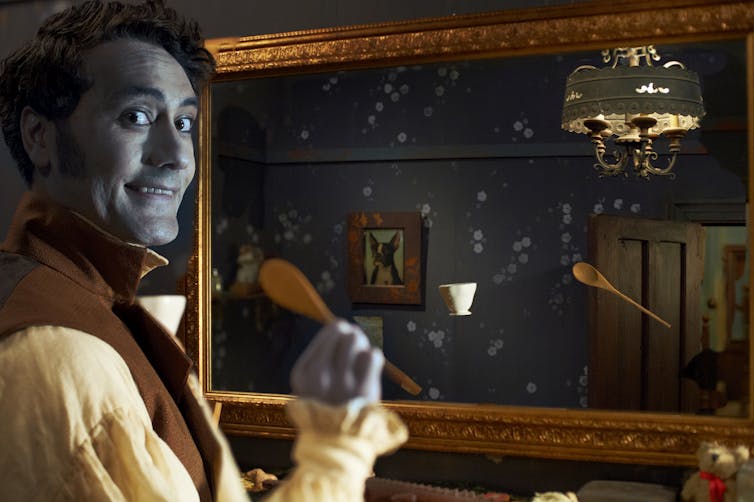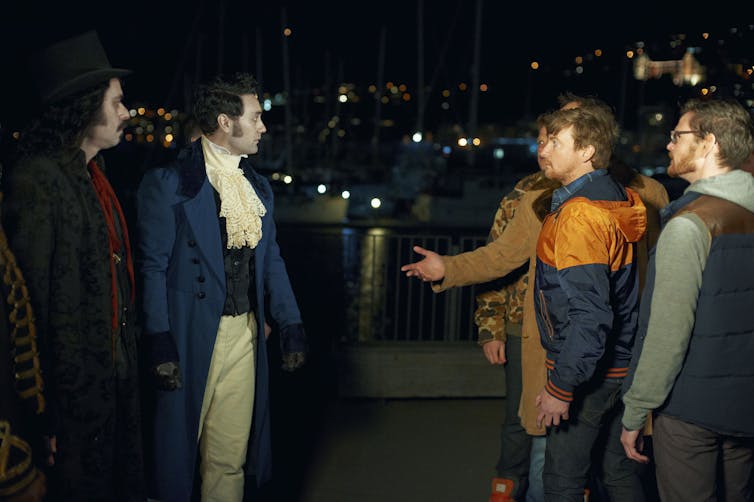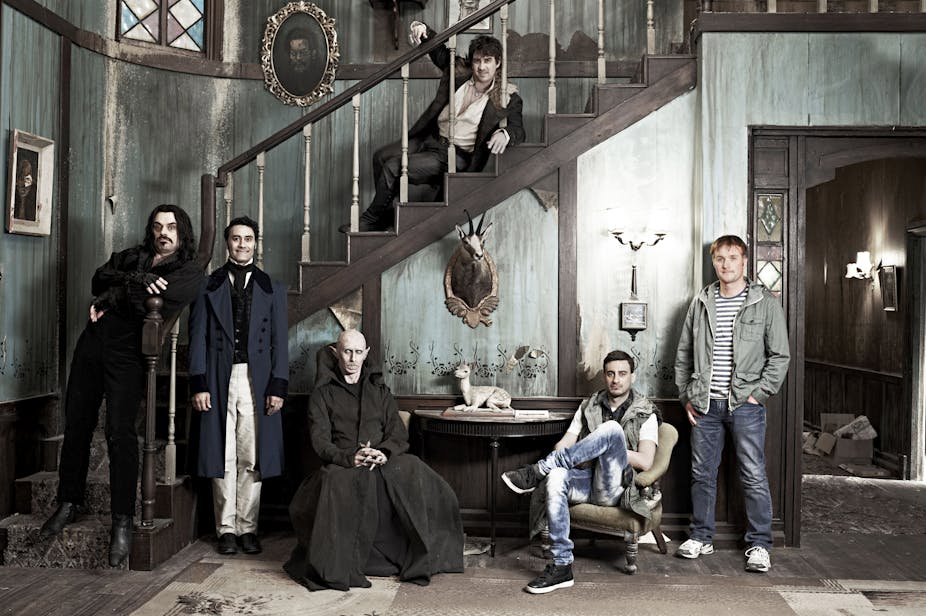Vampire films come in cycles. After the recent successes of the Twilight franchise and seven seasons of True Blood, comes the parody mockumentary, co-written and co-directed by Jemaine Clement, one half of the New Zealand comedy duo Flight of the Conchords.
You don’t have to be a handmaiden to the Dark Lord to enjoy What We Do in the Shadows. It’s perfect watching for those who scoff at Edward Cullen and miss the more self-reflexive episodes of Buffy – after all, this is a vampire movie that takes the piss out of vampires. And of course, it will certainly appeal to those well versed in vampire lore and psyched up to spot the references. Like all films in the genre, there are references aplenty.
The film opens with a banner saying:
Every few years a secret society gathers in New Zealand for a special event: THE UNHOLY MASQUERADE. In the months leading up to the ball, a documentary crew was granted full access to a small group of this society. Each crew member wore a crucifix and was granted protection by the subjects of the film.

We then follow the timid dandy Viago (think Spike, pre-vampire transformation in Buffy), the once-powerful Vladislav (late Nick Cave meets Gary Oldman as Dracula circa 1992) and Deacon (a fellow with a penchant for leather trousers and belly dancing). Together, they share a run-down house in Wellington, New Zealand. We have a glimpse into their everynight life in the run up to the much-anticipated event.
Along the way they welcome a new vampire called Nick into their midst, though he soon runs afoul of Deacon for copying his taste in faux-military jackets. Not unlike the early seasons of the BBC’s Being Human, the mundane practicalities of shared living are what provide much of the comedy here. The housemates try to make the best of their lack of social cachet – it’s a high point when they are finally admitted to one of the more popular local night clubs, Boogie Wonderland.
The charm of the film hinges on the total sincerity of Viago (Taika Waititi, who also co-wrote and co-directed the film) who fussily looks after his fellow vampires and pines for his ageing beloved, now in her 90s. “This is always really scary part for me”, he says at the opening of the film, cautiously peeping past the curtains. “Yesss! Night-time.” He is the foil to Vlad and Deacon as they tirelessly attempt to re-assert their vampire alpha-masculinity.

In this line, much of the humour arises from vampire powers and peculiarities and imagining them in a housemate context – joking around with the fact that they don’t appear in mirrors or being able to levitate. As such, the film successfully combines this comic documentary format whilst invoking other vampire texts.
There are many pleasurable references to modern classics and cult favourites, such as The Lost Boys (1987) as well as Twilight. The nods to Bram Stoker’s Dracula (Francis Ford Coppola, 1992) are particularly numerous, from Deacon’s chosen sleeping position to Vlad’s bouffant hairstyle and white Transylvanian high camp ensemble at The Unholy Masquerade. The most frequently cited film here in terms of visual style is Nosferatu (1922).

Like many house-shares, there is a rarely glimpsed, basement dwelling flatmate with poor hygiene skills. This is 8000-year-old Petyr, obviously styled as the twin of Max Schreck’s Count Orlok in Nosferatu. In terms of its use of documentary technique and style, the film is also indebted to both The Blair Witch Project (1999) and Haxan: Witchcraft Through the Ages (1922). And one of the most hilarious moments comes when Deacon performs what can only be described as something closely akin to the lascivious snake dance performed by Amanda Donohoe in Lair of the White Worm (1988) for the benefit of his bored housemates. What We Do in the Shadows is certainly citational, but the camp and cult go alongside the classics here.
Another recent addition to the vampire cinema genre is the sublime Only Lovers Left Alive (2013), and they’re well worth comparing. What We Do in the Shadows explores the the idea that eternal life means scraping by and remaining hopelessly uncool forever. Only Lovers Left Alive, on the other hand, suggests eternal life as the ideal situation for the artist and the truly curious. Eve (Tilda Swinton) and Adam (Tom Hiddleston) have used eternity to learn multiple languages, read everything, and create complex musical compositions (not unlike the Cullens in Twilight).

These two films illustrate the flexibility of the vampire genre. Only Lovers Left Alive is a continuation of the sincere, high-minded philosophical vampire film, while What We Do in the Shadows signals the genre’s ability to openly mock its own conventions.
The vampire genre thrives just because of of this flexibility. It’s a world in which certain rules remain coherent (silver is poisonous to vampires, werewolves and vampires have an age-old enmity, vampires can’t go out in the daylight) and so different interlinking stories can be built up around this scaffolding. The immortality of vampires also adds to this – it’s attractive to imagine that all these sub-groups of vampires exist at once, that Petyr in the basement really is Count Orlok’s twin – or Count Orlok himself.
So What We Do in the Shadows is much more than a spoof on the vampire film. It’s thoughtful, knowingly drawing on a long history of a variety of vampire cinema as well as a clever satire. And it’s downright hilarious. Watch it.

